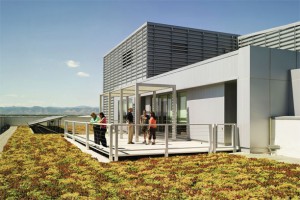The results are in…when it comes to the business case for sustainability, green buildings “walk the talk.”
In a recently issued white paper, GSA outlined the results of a post-occupancy evaluation study of 22 green federal buildings from across the country; the findings compared to national average commercial buildings:
- They cost less to maintain, by 19%
- They use less energy and water, by 25%
- They emit fewer carbon dioxide emissions, by 36% and
- They have more satisfied occupants, by 27%.
The study, conducted by the Pacific Northwest National Laboratory, built on a good indication of the potential for increased productivity and performance pilot research completed two years ago, with similarly impressive results.
For more than a decade, the federal government has declared its commitment to sustainable building though presidential directives and executive orders, congressional legislation and governmentwide policies. PBS began its sustainable design program in 1999, and they completed their first green roof in 1975.
There’s no question that focusing on sustainability is the right thing to do for our environment: commercial buildings account for 18% of the nation’s energy use. The numbers show that greening federal buildings in most cases makes good business sense, as well. By looking critically at real world performance, this report demonstrates that the GSA is very much on track to achieve its green building goals, and that GSA is delivering high-performance, sustainable workplaces federal agencies need to fulfill their missions on behalf of the American people.
Find out more by reading the white paper. BD+C
--
Related Stories
| Oct 27, 2011
iProspect selects VLK Architects for new office design
Company growth prompted iProspect to make the decision to move to a new space.
| Oct 27, 2011
ASSA Abloy, MAXXESS Systems announce U.S. Aperio integration
Aperio will integrate with MAXXESS's eAXxess and Efusion Event Management Software packages.
| Oct 26, 2011
Metl-Span selected for re-roof project
School remained in session during the renovation and it was important to minimize the disruption as much as possible.
| Oct 26, 2011
Shawmut Design and Construction awarded Tag Heuer build in Aventura, Fla.
New store features 1,200 sf fit out at Aventura Mall.
| Oct 25, 2011
HKS Science & Technology practice formed
Specializing in the planning and design of highly technical building types, HKS’s Science & Technology practice offers the broadest range of services available to the academic and biomedical research, biotechnology, pharmaceutical and medical device community, including laboratory programming, planning and design, strategic science planning and laboratory equipment planning.
| Oct 25, 2011
Universal teams up with Earthbound Corp. to provide streamlined commercial framing solutions
The primary market for the Intact Structural Frame is light commercial buildings that are typically designed with concrete masonry walls, steel joists and steel decks.
| Oct 25, 2011
Ritner Steel CEO elected to AISC Board
Freund will begin serving on the AISC board of directors, assisting with the organization's planning and leadership in the steel construction industry.
| Oct 25, 2011
DOE issues report on financing solar photovoltaic systems for K-12 schools
The report examines the two primary types of ownership models used to obtain solar installations. This analysis can help school administrators across the country select the best option for deploying solar technologies in their school districts.















